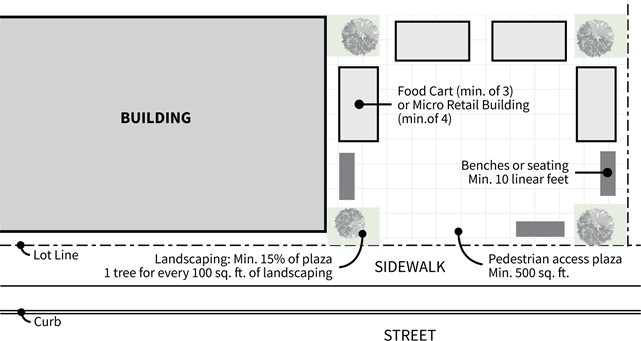230.315 Residential-Commercial Mixed Use Development.
A. Limitations on Residential Uses. Residential uses are limited in the NC Zone. All developments that include a residential use must meet the following two (2) standards:
(1) Mixed Use Development Requirement. Residential uses shall be permitted only when part of a mixed use development. Both “vertical” mixed use (housing above the ground floor), and “horizontal” mixed use (housing on the ground floor) developments are allowed, subject to subsection (A)(2) of this section. Number of units permitted is determined by required building and fire codes, setbacks, parking, building height, landscaping and other site requirements.
(2) Limitation on Street-Level Housing. No more than fifty (50) percent of the frontage on Halsey Street may be occupied by ground floor/street-level residential uses.
B. Flexible Nonresidential Uses in Mixed Use Developments. The following options are available to satisfy the requirement for a nonresidential use in a mixed use development:
(1) Conventional Commercial Space. Provide a minimum of one thousand (1,000) square feet of conventional, enclosed commercial space meeting all applicable standards of the building code.
(2) Food Pod. A food pod with four (4) or more mobile food units which meets the requirements of Section 345 and includes a pedestrian access plaza which meets standard P1 of the Main Streets on Halsey Design Standards (Table 230-6).
(3) Micro Retail Pod. A micro retail pod is a collection of retail shops or services which are operated in detached, prefabricated or mobile structures with associated site amenities. A micro retail pod must meet the following minimum standards:
(a) Number of Retailers. The site must provide sufficient area for a minimum of four (4) retailers. The site may also include up to three (3) food carts. If the site includes four (4) or more food carts, then the site must also meet the standards for a food cart pod in Section 345.
(b) Building Design.
i. Each individual building in a micro retail pod must not exceed six hundred (600) square feet in floor area.
ii. All buildings must be constructed with high-quality building materials that are compatible with other development on the site and the surrounding neighborhood. Prohibited materials include:
•Standard form concrete block (not including split-faced, colored or other block designs that mimic stone, brick or other similar masonry).
•Corrugated metal or fiberglass.
•Plastic or vinyl siding.
•Shipping containers.
iii. All buildings must meet any applicable building code requirements associated with their intended use and occupancy.
(c) Site Improvements and Amenities (See Figure 230-1).
i. The micro retail pod must include a pedestrian access plaza which meets standard P1 of the Main Streets on Halsey Design Standards (Table 230-6).
ii. All buildings must orient their main entry or shopfront window to a pedestrian access plaza or to a public street.
iii. On-site restrooms shall be provided for employees and customers and be screened from view.
iv. Waste and recycling receptacles shall be provided for customer and business waste and be screened from view.
v. Lighting must be provided to illuminate the area when retailers operate during hours of darkness. No direct light source shall be visible from the property line. Lighting fixtures shall be oriented and/or shielded to prevent glare on abutting properties.
Figure 230-1. Food Cart or Micro Retail Pod

(Ord. 3-2021 § 1 (Exh. A))